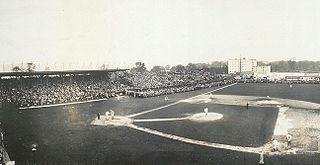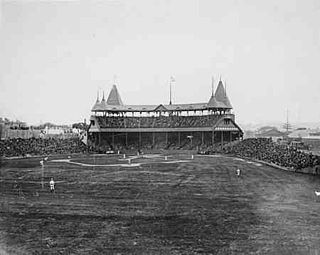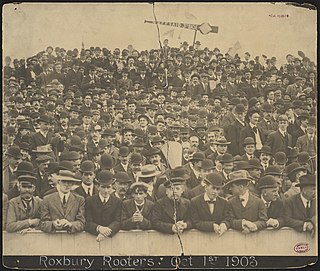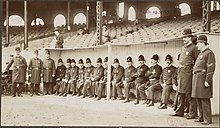
The Polo Grounds was the name of three stadiums in Upper Manhattan, New York City, used mainly for professional baseball and American football from 1880 to 1963. The original Polo Grounds, opened in 1876 and demolished in 1889, was built for the sport of polo. Bound on the south and north by 110th and 112th streets and on the east and west by Fifth and Sixth (Lenox) avenues, just north of Central Park, it was converted to a baseball stadium when leased by the New York Metropolitans in 1880.

Braves Field was a baseball park located in Boston, Massachusetts. Today the site is home to Nickerson Field on the campus of Boston University. The stadium was home of the Boston Braves of the National League from 1915 to 1952, prior to the Braves' move to Milwaukee in 1953. The stadium hosted the 1936 Major League Baseball All-Star Game and Braves home games during the 1948 World Series. The Boston Red Sox used Braves Field for their home games in the 1915 and 1916 World Series since the stadium had a larger seating capacity than Fenway Park. Braves Field was the site of Babe Ruth's final season, playing for the Braves in 1935. From 1929 to 1932, the Boston Red Sox played select regular season games periodically at Braves Field. On May 1, 1920, Braves Field hosted the longest major league baseball game in history: 26 innings, which eventually ended in a 1–1 tie.

Exposition Park was the name given to three historic stadiums, located in what is today Pittsburgh, Pennsylvania. The fields were used mainly for professional baseball and American football from c. 1879 to c. 1915. The ballparks were initially located on the north side of the Allegheny River in Allegheny City, Pennsylvania. The city was annexed into Pittsburgh in 1907, which became the city's North Side, located across from Pittsburgh's downtown area. Due to flooding from the nearby river, the three stadiums' exact locations varied somewhat. The final version of the ballpark was between the eventual sites of Three Rivers Stadium and PNC Park.

Hilltop Park was the nickname of a baseball park that stood in the Washington Heights neighborhood of Manhattan. It was the home of the New York Yankees of Major League Baseball from 1903 to 1912 when they were known as the "Highlanders". It was also the temporary home of the New York Giants during a two-month period in 1911 while the Polo Grounds was being rebuilt after a fire.

South End Grounds refers to any one of three baseball parks on one site in Boston, Massachusetts. They were home to the franchise that eventually became known as the Boston Braves, first in the National Association and later in the National League, from 1871 through part of the 1914 season. That stretch of 43 1/2 seasons is still the longest tenure of the Braves club at any of their various ballparks and cities since 1914.

"Tessie" is both the longtime anthem of Major League Baseball (MLB)'s Boston Red Sox and a 2004 song by the punk rock group Dropkick Murphys. The original "Tessie" was from the 1902 Broadway musical The Silver Slipper. The newer song, written in 2004, recounts how the singing of the original "Tessie" by the Royal Rooters fan club helped the Boston Americans win the first World Series in 1903. The name Tessie itself is a diminutive form used with several names, including Esther, Tess, and Theresa/Teresa.

In baseball, the dead-ball era lasted from about 1900 to 1920. This era was characterized by low-scoring games and a lack of home runs; in 1908, the major league batting average dropped to .239, and teams averaged just 3.4 runs per game, the lowest ever. Spacious ballparks limited hitting for power, and the ball itself was "dead" both by design and from overuse. Ball scuffing and adulteration by pitchers, particularly the spitball, were allowed, putting hitters at a disadvantage.

The Royal Rooters were a fan club for Boston's professional baseball team in the American League in the early 20th century. The team was known as the Boston Americans during the 1901–1907 seasons, and has been known as the Boston Red Sox since the 1908 season. The Royal Rooters disbanded in 1918.

Pelican Stadium, originally known as Heinemann Park (1915–1937), was a sports stadium in New Orleans, Louisiana from 1915 to 1957.

Huntington Avenue is a thoroughfare in the city of Boston, Massachusetts, beginning at Copley Square and continuing west through the Back Bay, Fenway, Longwood, and Mission Hill neighborhoods. It is signed as Massachusetts Route 9. A section of Huntington Avenue has been officially designated the Avenue of the Arts by the city of Boston.

The Boston Reds of 1884 were a professional baseball team that competed in the short-lived Union Association.

Michael T. "Nuf Ced" McGreevy was an American businessman and baseball fanatic. He was the leader of the most vocal fans of the Boston Americans, known as the "Royal Rooters", and owner of a Boston bar called the Third Base Saloon.
The Roanoke Red Sox was a primary name of the minor league baseball teams based in Roanoke, Virginia. Between 1894 and 1953, Roanoke teams played as members of the Virginia League and Piedmont League (1943–1953), winning five league championships and one pennant. Roanoke teams were a minor league affiliate of the Cleveland Indians in 1940 and Boston Red Sox from 1943 to 1953. Baseball Hall of Fame members Jack Chesbro (1896) and Heinie Manush (1943) played for Roanoke.

Ban Johnson Park was a baseball stadium located in Hot Springs, Arkansas. It was also known as Whittington Park and McKee Park. The ballpark was located within today's Whittington Park Historic District and directly across from the still active Arkansas Alligator Farm and Petting Zoo.
The St. Paul Saints were a 20th-century Minor League Baseball team that played in the American Association from 1901 to 1960 in the city of St. Paul, Minnesota. The 1920, 1922, and 1923 Saints are recognized as being among the 100 greatest minor league teams of all time.
The original Majestic Park was one of the first Major League Baseball spring training facilities. The ballpark was located at the corner of Belding Street and Carson Street in Hot Springs, Arkansas. Today, the site is in use by Champion Christian College, National Park College, and travel/tournament baseball and softball. Majestic Park has been renovated by the City of Hot Springs. Babe Ruth, Cy Young, Jackie Robinson and Hank Aaron are among the many who have played at the site.






















